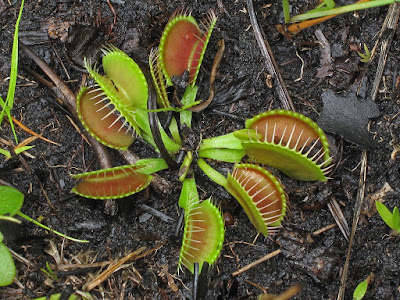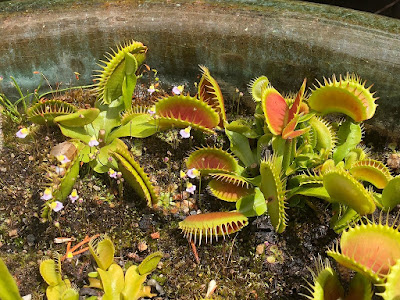Venus flytrap is native to subtropical wetlands on the East Coast of the United States in North Carolina and South Carolina. It is one rare carnivorous plant that grows in open habitats on the rims of Carolina bays.
Venus flytrap also called as Dionaea muscipula, Dionaea corymbosa, Dionaea crinita, Dionaea dentata, Dionaea heterodoxa, Dionaea muscicapa, Dionaea sensitiva, Dionaea sessiliflora, Dionaea uniflora, Drosera corymbosa, Drosera sessiliflora, Drosera uniflora, is a carnivorous plant of the genus Dionaea. This species was described by Daniel Solander ex John Ellis in 1768.
IDENTIFY VENUS FLYTRAP - DIONAEA MUSCIPULA CARNIVOROUS PLANT
Venus flytrap is native to subtropical wetlands on the East Coast of the United States in North Carolina and South Carolina. It is one rare carnivorous plant that grows in open habitats on the rims of Carolina bays.
It forms a basal rosette of distinct leaves that are attached to a short rhizome. The leaf blade consists of two kidney-shaped, hinged, sensitive lobes up to 25 mm long with stiff marginal hairs to 8 mm long.
Flowers are borne in an umbelliform cyme at the top of a 10 to 30 cm tall scape, with 5 white petals that are 11-13 mm long. The monecious flowers (male and female plant parts in separate flowers on the same plant) contain one stigma and 10 to 20 stamens. The capsule is 3-4 mm long. Venus flytrap flowers from May to June, and the fruits mature in June and July.
Dionaea muscipula has traps which are modified leaves and are a very effective trap closing in fractions of a second on unsuspecting prey. There are trigger hairs on the inside of the trap. To operate the trap one or more of these hairs needs to be touched within a period of about five seconds. Each trap can only operate three or four times before it becomes ineffective and for this reason the temptation to trip the traps should be avoided as much as possible since this can weaken the plant.
There can be considerable variation in the colour, size and form of the traps and many different clones of the same plant can be found. Some plants have traps that have moderate red colour inside, others that have intense red colour on the inside the trap. Other forms have traps and leaves that are intensely red allover. Variations in the trap size can also be found (small, large and giant!) and other variants have reduced outer teeth(shark’s tooth) or teeth that have fused together.
VENUS FLYTRAP - DIONAEA MUSCIPULA CARNIVOROUS PLANT CARE AND CULTURE
Cultural information should only be used as a guide, and should be to be adapted to suit you. Your physical location; where you grow your plants, how much time you have to devote to their care, and many other factors, will need to be taken into account. Only then can you decide on the cultural methods that best suit you and your plants.
Light:
Venus Flytraps love full sun and are ideal for a sunny windowsill or conservatory. They are warm temperate plants and grow much better outside where they get rain, hot days and warm nights. They also have an endless supply of insects to eat outdoors. Full sun is very important and a north facing windowsill is not sunny enough for them to grow well.
Substrate, growing media and repotting:
Dionaea muscipula can be grown in a variety of different composts but the best is probably a mix of peat with perlite and lime-free sand in about equal parts by volume. Coir may be a potential alternative or part substitute to peat for Dionaea, and has been used successfully by some growers. The aim should be to have a moisture retentive but open medium.
Watering:
Watering should be by the tray system. Dionaea muscipula should be allowed to stand in a few centimeters of water during the growing season. The reason most people fail with Venus Flytraps, is using the wrong water. They need rainwater, soft water or distilled water. Try to avoid hard tap water, but remember that if you have run out of water, tap water is better than nothing occasionally. Do not allow the plant to dry out fully especially in spring/summer.
Feeding:
It is not usually necessary to feed your plant, but if you wish, you can feed it live prey. Wood lice are quite easy. Do not use dead insects and never use fertilizer. Old insects will stay in the trap and may help attract the next victim. Each trap only catches around three insects, and then it dies back, goes black and a new trap will replace it.
Rest period:
New growers often make the mistake of thinking that these are tender tropical plants and try to keep them growing all year round. Venus flytrap actually need the winter rest and often they will be killed by too much kindness!
Giving them a good long dormancy is very important. If you bring them inside in the winter to keep them growing they will decline over time. They like to be very chilly in winter, but do not like to freeze! You can keep them in an unheated basement in winter, or an unheated garage.
Another way to give your plant a good winter rest is to unpot it and wash off all soil, cutoff all dead leaves and put it in a zip lock bag. Before sealing the zip lock bag a quick shot or two of a liquid fungicide will help protect the rhizome during dormancy. Then you put the bag in a container in your refrigerator. You do this just before your first frost in the fall and keep it in the fridge until mid March. They do not need light while dormant. This works very well. Pot the plant up again in the Spring, be careful of late frosts. Put the plant out in full sun again and just let it be. They do very well on there own and do not need much summer care other than watering. As old traps die, new ones will grow to replace them. Clip any dead or dying leaves and traps to keep it looking nice.















COMMENTS